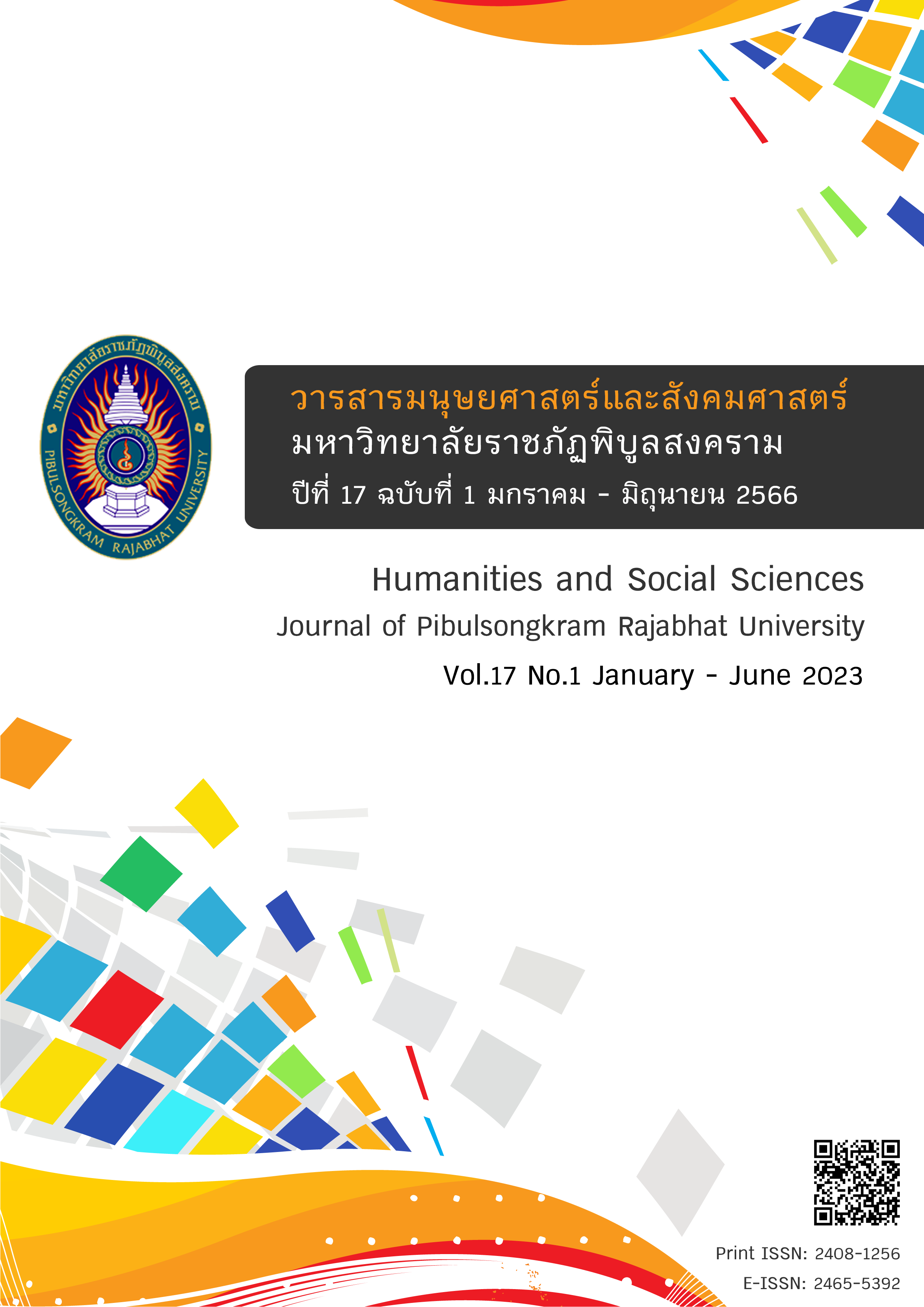Cinema of Wisdom: The use of film media to promote morality, ethics and reduce cyberbullying in youth
DOI:
https://doi.org/10.14456/psruhss.2023.8Keywords:
Cyberbullying, Social media, Film media promotes morality and ethicsAbstract
The objectives of this research are 1) to experiment with using films as a medium to create recognition in reducing cyberbullying behavior of youth through online social media, 2) to study to effect of using academic film media to promote morality and ethics, and create recognition in reducing cyberbullying behavior of youth in school. This study employed mixed method research by collecting quantitative data to obtain the overview of the study. Then the samples were screened for the qualitative research through in-depth study of the data. The population of this study was 53 primary-level students from Wat Adisorn School, ranging from Prathom 2 to 6. Screening the sample population for the qualitative research resulted in a group of 15 students for the study. The quantitative data indicated that out of 53 students 64.2% were male; 22.6% each were in Prathom 3 and 4; 58.5% lived with their parents; 79.2% of the parents were employees; 100% used or knew of at least one social media platform; 98.1% used social media through mobile phones; and 43.4% spend less than one hour on social media in one day; and 100% realized that bullying was bad. Furthermore, when one focused on those having no recognition of cyberbullying through social media, one discovered that 13.2% did not recognize cyberbullying through social media with higher percentage of male than female (57.1% vs. 42.9%); 42.9% each studied in Prathom 3 and 5; 71.4% lived with their parents; 85.7% of the parents were employees; 100% used or knew of at least one social media platform; 100% used social media through mobile phones; and 42.9% each spend less than one hour or more than six hours on social media in one day; 100% realized that physical bullying was bad; and 100% realized that cyberbullying through social media was bad. After viewing the film media, the sample group gained better understanding about cyberbullying through social media and were able to explain the content of the film showing that cyberbullying was bad. They also empathized with the ones being bullied as well as the bullies on the impact in various aspects. Moreover, the sample group did not want to be either the one being bullied or the bully, bringing about the intention to reduce their cyberbullying behaviors eventually.
References
กองบังคับการปราบปรามการกระทำความผิด เกี่ยวกับอาชญากรรมทางเทคโนโลยี. (2562) ประเภทของการกลั่นแกล้งทางอินเทอร์เน็ต. สืบค้นเมื่อวันที่ 10 มิถุนายน 2562. จาก https://tcsd.go.th//ประเภทของการกลั่นแกล้ง.
กอบกูล จันทรโคลิกา. (2553). การเลือกชมภาพยนตร์ที่โรงภาพยนตร์และความคาดหวังจากการชมภาพยนตร์ไทย. Thailand and The World Economy, 28(1), 122–153.
ขนิษฐา สมใจ. (2560) การเปิดรับทัศนคติ และพฤติกรรมการชมภาพยนตร์นอกกระแส ในโรงภาพยนตร์เฮ้าส์อาร์ซีเอ (วิทยานิพนธ์วารสารศาสตรมหาบัณฑิต). กรุงเทพฯ: คณะวารสารศาสตร์และสื่อสารมวลชน มหาวิทยาลัยธรรมศาสตร์.
ชวิน สุธาทิพย์กุล. (2561). พฤติกรรมการเปิดรับสื่อดิจิทัล และความพึงพอใจในสื่อดิจิทัลของผู้มาใช้บริการโรงภาพยนตร์เฮาส์ (วิทยานิพนธ์นิเทศศาสตรมหาบัณฑิต). กรุงเทพฯ: มหาวิทยาลัยกรุงเทพ.
ชินดนัย ศิริสมฤทัย. (2561). การรับรู้ ทัศนคติ และความตั้งใจในการเกิดพฤติกรรมการกลั่นแกล้งบนโลกไซเบอร์ (วิทยานิพนธ์นิเทศศาสตรมหาบัณฑิต). กรุงเทพฯ: มหาวิทยาลัยกรุงเทพ.
ณัฐรัชต์ สาเมาะ, พิมพวัลย์บุญงคล, และรณภูมิ สามัคคีคารมย์ (2557) การรับรู้ของเยาวชนต่อการรังแกในพื้นที่ไซเบอร์. วารสารพฤติกรรมศาสตร์เพื่อการพัฒนา, 6(1), 351-364.
ธันยากร ตุดเกื้อ. (2556). การพัฒนาตัวบ่งชี้พฤติกรรมการรังแกบนโลกไซเบอร์ของเยาวชนในจังหวัดสงขลา(วิทยานิพนธ์ปริญญาศิลปศาสตรมหาบัณฑิต). สงขลา: มหาวิทยาลัยสงขลานครินทร์.
นารีนารถ หอไธสง. (2555). การใช้ภาพยนตร์เพื่อพัฒนาทักษะภาษาอังกฤษ : การวิจัยปฏิบัติการรูปแบบวงจรลําดับเวลาของเจมส์ แมคเคอร์แนน (James McKernan). วารสารวัดผลการศึกษา, 17(1), 187-199.
นิด้าโพลแห่งประเทศไทย. (2560). ทัศนคติของเด็กและเยาวชนต่อ พฤติกรรมการกลั่นแกล้งบนโลกไซเบอร์. สืบค้นเมื่อ 29 มิถุนายน 2563 จาก https://www.facebook.com/thaibja/posts.
บุปผา ปงลังกา, ศิตา เยี่ยมขันติถาวร, และอารีรักษ์ มีแจ้ง. (2559). ผลการใช้ภาพยนตร์แอนิเมชั่นเพื่อพัฒนาความสามารถทางด้านการพูดภาษาอังกฤษและความพึงพอใจในการเรียนของนักเรียนชั้นมัธยมศึกษาปีที่ 3 โรงเรียนพร้าววิทยาคม จังหวัดเชียงใหม่. วารสารอิเล็กทรอนิกส์การเรียนรู้ทางไกลเชิงนวัตกรรม, 6(1), 45-60.
ประวีณา พลเขตต์. (2561). การรับรู้และการรู้เท่าทันสื่อของผู้ชมรายการชัวร์ก่อนแชร์. วารสารการสื่อสารและการจัดการนิด้า, 4(3), 47-62.
ปองกมล สุรัตน์. (2561). การรังแกผ่านโลกไซเบอร์ในมิติสังคมวัฒนธรรม : กรณีศึกษาเยาวชนไทยเจนเนอเรชั่น Z (วิทยานิพนธ์ปรัชญาดุษฎีบัณฑิต). กรงเทพฯ: มหาวิทยาลัยศรีนครินทรวิโรฒ.
พรชนก ดาวประดับ, และกัลยกร วรกุลลัฎฐานีย์. (2561). รูปแบบและลักษณะการมีส่วนร่วมในการกลั่นแกล้งบนพื้นที่สาธารณะออนไลน์. วารสารการสื่อสารและการจัดการ นิด้า, 4(3), 63-78.
พรทิพย์ เย็นจะบก. (2560). เอกสารคำสอนวิชาหลักนิเทศศาสตร์. กรุงเทพฯ: คณะมนุษยศาสตร์ มหาวิทยาลัยเกษตรศาสตร์.
พีระ จิระโสภณ. (2523). หลักและทฤษฎีการสื่อสาร. นนทบุรี: มหาวิทยาลัยสุโขทัยธรรมาธิราช.
มูลนิธิพิทักษ์สิทธิเด็ก. (2559). เมื่อเด็กถูกเพื่อนรังแกในโรงเรียน...ผู้ใหญ่จะช่วยเหลืออย่างไร?. สืบค้นเมื่อ 29 พฤศจิกายน 2563. จาก https://www.thaichildrights.org/articles/article-violence.
มูลนิธิยุวพัฒน์. (2562). การกลั่นแกล้ง (Bullying) ความรุนแรงในสังคม. สืบค้นเมื่อ 29 มิถุนายน 2563 จาก https://www.yuvabadhanafoundation.org/th.
มูลนิธิส่งเสริมสื่อเด็กและเยาวชน. (2561). การกลั่นแกล้งบนโลกไซเบอร์ (Cyberbullying). ปทุมธานี: นัชชาวัตน์.
ราชบัณฑิตยสถาน. (2542). พจนานุกรม ฉบับราชบัณฑิตยสถาน : ภาพยนตร์. กรุงเทพฯ: นานมีบุ๊คส์พับลิเคชั่นส์.
ฤตานนท์ แสนสวย. (2559). การเปิดรับภาพยนตร์โฆษณาในรูปแบบ In-stream ad บน Youtube และพฤติกรรมการตอบสนองของผู้ชม (วิทยานิพนธ์วารสารศาสตรมหาบัณฑิต). กรุงเทพฯ: มหาวิทยาลัยธรรมศาสตร์.
วรารัตน์ สนธิมุล. (2559). พฤติกรรมการเปิดรับโฆษณาภาพยนตร์ผ่านสื่อสังคมออนไลน์เฟซบุ๊กกับการตัดสินใจเลือกชมภาพยนตร์ของผู้ชม (วิทยานิพนธ์ปริญญานิเทศศาสตรมหาบัณฑิต). กรุงเทพฯ: มหาวิทยาลัยเกษมบัณฑิต.
วลัยลักษณ์ ทองสะอาด. (2558). การสอนโดยใช้ภาพยนตร์ตามแนวคิดของ Goodwyn เพื่อพัฒนาทักษะการฟังภาษาอังกฤษ-การคิดอย่างสร้างสรรค์ในวิชาภาษาอังกฤษฟัง-พูด1 ของนักเรียนระดับ ประกาศนียบัตรวิชาชีพชั้นปีที่ 2 วิทยาลัยเทคโนโลยีหมู่บ้านครู. กรุงเทพฯ: วิทยาลัยเทคโนโลยีหมู่บ้านครู.
วิชชา สันทนาประสิทธิ์. (2558). บทบาทของภาพยนตรกับพฤติกรรมทางเพศของวัยรุน ไทย: กรณีศึกษานักศึกษา มหาวิทยาลัยราชภัฏสวนสุนันทา. กรุงเทพฯ: สถาบันวิจัยและพัฒนา มหาวิทยาลัยราชภัฏสวนสุนันทา.
สรานนท์ อินทนนท์, และพลินี เสริมสินสิริ. (2561). การศึกษาวิธีการป้องกันการกลั่นแกล้งบนโลกไซเบอร์ของวัยรุ่น. ใน การประชุมวิชาการและนำเสนอผลงานวิชาการระดับชาติ UTCC Academic Day ครั้งที่ 2. กรุงเทพฯ: มหาวิทยาลัยหอการค้าไทย.
สำนักงานกองทุนสนับสนุนการสร้างเสริมสุขภาพ (สสส). (2562). Cyberbully คืออะไร? ส่งผลอย่างไร? และเราควรรับมือกับมันอย่างไรดี?. สืบค้นเมื่อ 10 กันยายน 2563. จากhttps://resourcecenter.thaihealth.or.th/ index.php/article/cyberbully.
สุธรรม รัตนโชติ. (2553). พฤติกรรมองค์การและการจัดการ. กรุงเทพฯ: สำนักพิมพ์ท้อป.
สุภาวดี เจริญวานิช. (2560). การรังแกกันผ่านพื้นที่ไซเบอร์ : ผลกระทบและการป้องกันในวัยรุ่น. วารสารวิทยาศาสตร์และเทคโนโลยี, 25(4), 639-648.
อภิญญา แก้วเปรมกุศล. (2562). การเปิดรับสื่อ การรับรู้ ทัศนคติ และการใช้ประโยชน์จากหลักปรัชญาของเศรษฐกิจพอเพียง ของเยาวชนในเขตกรุงเทพมหานคร. Management Science Nakhon Pathom Rajabhat University, 6(2), 20 - 35.
Ball-Rokeach, S. J., & DeFleur, M. L. (1976). A dependency model of mass-media effects. Communication Research, Retrieved August 10, 2020,/from / https://doi.org/10.1177/009365027600300101.
Frederick W. Frey. (1963). Communications and political development. Princeton, N.J. Princeton University.
McCombs, M. E., & Becker, L. B. (1979). Using mass communication theory. New York: Prentice-Hall.
Unicef. (2020). Cyberbullying: What is it and how to stop it. Retrieved September 15, 2020,/from/https://www.unicef.org/end-violence/how-to-stop-cyberbullying
Downloads
Published
How to Cite
Issue
Section
License
Copyright (c) 2022 Humanities and Social Sciences Journal of Pibulsongkram Rajabhat University

This work is licensed under a Creative Commons Attribution-NonCommercial-NoDerivatives 4.0 International License.
Any articles or comments appearing in the Journal of Humanities and Social Sciences, Rajabhat Phibulsongkram University, are the intellectual property of the authors, and do not necessarily reflect the views of the editorial board. Published articles are copyrighted by the Journal of Humanities and Social Sciences, Rajabhat Phibulsongkram University.









